My comedy career began on October 21, 2004, with a shortform improv comedy show in Smith Hall on The Ohio State University’s campus.
On February 11, 2016, : 11 years, 3 months, and 21 days: later, I performed my 1,000th show: as a stand-up comedian, improviser, storyteller, spoken word artist, and sketch performer.
Because I’m an engineer, I tracked all of those performances in an Excel spreadsheet and decided to analyze the data to celebrate the passing of the millennial performance.
Did I perhaps go too far in the analysis? Probably. Did I wish I had even more data to analyze? Absolutely.
To give you a sense of what all I analyzed, here are some tidbits of what I learned:
- I performed: 1,000 shows: in 4,130 days or roughly 1 show every 4 days.
- I performed: 7 types of shows, though shortform and stand-up were by far the most frequent.
- I performed for 681 hours or roughly 28 days.
- I performed in front of an estimated 41,240 people.
- I performed in 104 cities, in 45 states, in 3 countries, and on 2 continents.
- I performed at least once every month from December 2007 to February 2016 (a streak of 99 months).
Now for the deep dive…
Performances by Type
The first thing: I wanted to know was the breakdown of performances by type.

Over the 1,000 shows, I tried: improv (shortform, longform, and musical), stand-up, spoken word, storytelling, and sketch. (I also acted in a few things, but this is all about the live performances.)
#1. Improv (673 shows)
Improv was the clear majority at 67.3% of my performances.: This makes sense as I started my performing career by helping co-found the 8th Floor Improv Comedy Group at OSU, I’ve been a member of ComedySportz since 2008, and I was on multiple house teams at The Magnet: in NYC.
#2. Stand-up (300 shows)
Next up was stand-up, which I began in 2005. A few: of us in the improv group felt that if we could be funny when making things up, we should be able to be funny when we had a plan.
(Turns out, at least for me, stand-up is a lot harder than improv but with practice and time, it gets easier and is a lot of fun.)
#3. Spoken Word (22 shows)
Much further behind that was spoken word, which I didn’t really start doing until 2015, when I started performing at more music venues and poetry shows.: Stand-up isn’t necessarily forbidden in these types of venues (though it sometimes is), it is certainly much harder to pull off.
#4. Storytelling (3 shows)
I only had: 3: storytelling performances, but the last one was a major milestone: my 1,000th show in my 50th state on my 32nd birthday. To see the story, watch The Story of My Year as a Nomad.
#5. Sketch (1 show)
I did: exactly 1 sketch show: a 5-minute sketch for a friends 30th Birthday party in front of 25 people on August 17, 2013. So far, that’s been enough.
Improv (Shortform) vs Improv (Longform) vs Improv (Musical)
I was also curious of the breakdown of the different styles of improv as defined by shortform (such as Whose Line Is It Anyway and ComedySportz), longform (such as UCB and The Magnet), and musical (such as Baby Wants Candy and my team, Mint Condition).

#1. Shortform (436 shows)
Again there was a clear winner with shortform at 64.8% of shows. This makes sense given that the 8th Floor was shortform when we started, my first touring group, Smarty Pants, was shortform, and I performed with ComedySportz in 20: of their 25 cities.
#2. Longform (172 shows)
Longform was next, where I performed at UCB, The Magnet, and on a number of different indie teams throughout NYC.
#3. Musical (66 shows)
I performed: musical the least, where nearly all of my performances came at The Magnet in the form of class shows and the aforementioned Mint Condition.
Performances by Type (More Detailed Version)
Comparing the different styles of improv against all types of performances: shifted the rankings.
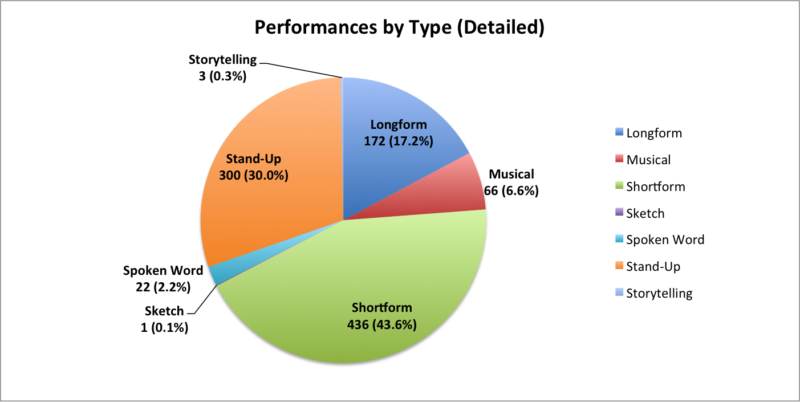
Shortform improv was still in the lead at 43.6% but second was stand-up at 30.0%, ahead of longform (17.2%) and musical (6.6%). And still only 1 sketch performance.
Thoughts: on Performances by Type
- Diversity of performance is good.: Over the course of 1,000 shows, I did 7 types of performance: longform improv, musical improv, shortform improv, sketch, spoken word, stand-up, and storytelling. Trying different: types made me an overall stronger performer (and person). There’s a lot a stand-up can learn from improvising, a storyteller can learn from spoken word, and an engineer can learn from all of the above.
- I’m most comfortable performing shortform.: Shortform was the most frequent performance type; it’s the first type of performance I ever did starting in 2004 and I’ve been doing it every year since. When I first started out, I was incredibly nervous before every show. Now, 400+ shows later, I’m not nervous to perform, just excited.
- I’m not a good actor.: I’ve only done one sketch show for a reason: I’m not very good at acting. Specifically, I’m not very good at making it look like I’m hearing something for the first time. Certainly I would get better at it if I did it more, but I prefer the other types of performance better so I haven’t given: it much focus.
Performances by Group
Along the lines of understanding my performances by type, I was also interested in the performances I had by group.
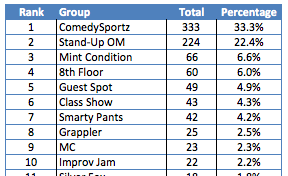
Over the last 11+ years, I performed with 31 “groups.” In the world of improv and sketch, groups referred to the teams with whom I performed on stage; in the world of stand-up, spoken word, and storytelling, they: referred to the type of show I did (I wasn’t all that interested in how many different open mics I’ve done).
#1 ComedySportz (333 shows)
ComedySportz was #1 with one-third of all my performances being with the family friendly, shortform improv organization. A majority of those shows were with my hometown CSzNYC, but there were tons of other shows with teams from all around the country.
It’s one of the biggest families of improvisers on the planet and I’m proud to be a member.
#2 Stand-Up Open Mics (224 shows)
Just about every stand-up comic starts out at the open mic level. It’s where you cut your teeth as a comedian and work on new material for future shows (it’s also where I prep material for speaking engagements). Those workout rooms made up 22.4% of my performances with a whopping 224 shows. That’s a lot of performing to mostly other comedians.
Other stand-up related groups included guest spots (#5 at 49 shows) and being the MC (#9 at 23 shows).
A side note on stand-up: Though stand-up is generally perceived as a lonelier performance type (at least compared to improv), I found that I stuck mostly to a core set of organizations, which allowed: me to build relationships with other comedians and not feel alone in the process.
Of the 300 total stand-up shows I did, 69.7% were: with just four organizations:
- Laughing Buddha Comedy – 125 shows (41.7%)
- Comic Strip Live – 46 shows (15.3%)
- Funny Bone Comedy Clubs – 27 shows (9.0%)
- Monday Night Mirth – 11 shows (3.7%)
#3. Mint Condition (66 shows)
Mint Condition, the musical improv group I was apart of at The Magnet, was #3 with 66 shows. It was one of my favorite groups to perform with because every member brought a different skill to the table. And we made each other mixtapes.
At the time of my retirement from the team (I had to step down due to travel), it was the second longest running musical house team at The Magnet.
Rounding Out the Top 10
The 8th Floor was #4 at 60 shows, 34 of which: were: from when I was still in college and 26: were: as an alumnus of the group.
I was in 43 class shows (#6), 22 improv jams (#10), and participated in 9 auditions, including callbacks (#15). Side note on the auditions: I made 50% of the things I auditioned for.
- 2008 – ComedySportz NYC (made it)
- 2008 – House Team at The City (group never happened)
- 2009 – Harold Team at UCB (didn’t make it)
- 2009 – Stand-Up at Comic Strip Live (didn’t pass)
- 2011 – Musical House Team at Magnet (made it)
- 2011 – Longform team at Magnet (made it)
The remaining Top 10 groups were Smarty Pants (#7), the first professional group I was apart of, and Grappler (#8), my first longform team at The Magnet.
A few shout-outs to groups not in the Top 10:
- The Danboys (#13 with 16 shows). Another indie group but this one comprised of 8th Floor Alumni who had moved to NYC. As the first alum to move to NYC, it was a great feeling to be joined by fellow talented people in the Big Apple.
- Slapstick Picknick (#18 with 7 shows). My first indie group and the most diverse in terms of performance, covering longform, shortform, and sketch.
- Speechless Live (#20 with 3 shows). One of my favorite shows to do as it combines improv and presentations and seems to be right in my wheelhouse for performance.
Thoughts: on Performances by: Group
- Comedy doesn’t have to be lonely.: Regardless of performance type, I’ve found a community of welcoming performers wherever I’ve gone. Yes, there are unfriendly people in every type, but if: you can find the people who you connect with, it makes the process a lot more fun.
- The audience has fun when you have fun.: When I reflect on my favorite groups, they’re often the most successful ones and the ones where I had the most fun when performing. I don’t think that’s a coincidence; I think when you have fun on stage, either because of the material you present or the people you’re performing with, the audience feeds off that energy and has fun with you.
- You have to start somewhere.: I was surprised to learn that 43% of my performances with my college improv group came after I graduated from college, in the form of a post-graduation summer run, special event shows, and alumni shows. When we started the group, we had no idea how long it was going to last, and it’s still going 12 years later. We just started somewhere and decided to see where it would take us.
Performances by Duration
The next thing I became curious about was how long I actually performed each type of comedy.
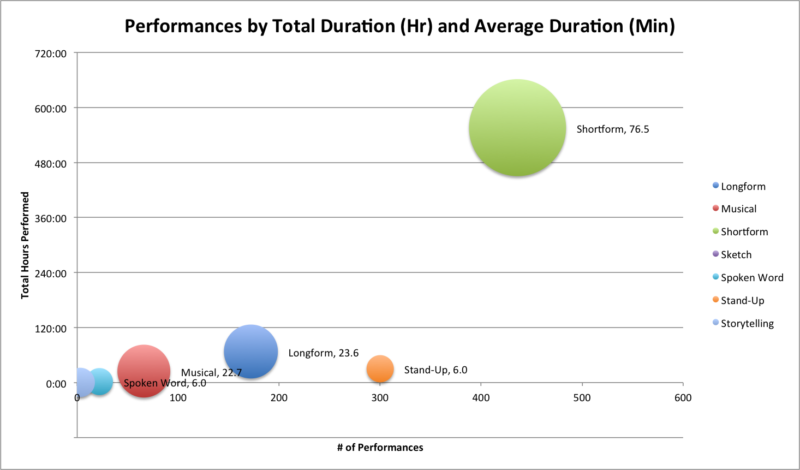
In total, I performed for roughly 681 hours (or 28 days), with 95% of that time doing improv.: The average duration of each performance was 40 minutes, though it varied greatly by performance type.
The longest show I did: was: 2 hours, which I did multiple: times. The shortest show was 4 minutes, which also occurred multiple times (thanks to some open mics). 41.3% of my shows were: for at least an hour; 28% were: for 5 minutes or less.

#1. Shortform (556 hours)
I performed more hours of shortform than all of the other performance types combined (556 vs 125). This was: partly due to the number of performances (436), but also due to the fact that my shortform shows were the longest of any performance type at an average of 75 minutes per show.
#2. Longform (67 hours)
Despite performing longform half the number of times as stand-up: (172 vs 300), I had double the number of: hours (67 hours vs 30 hours). This was due to the fact that my: average longform show was nearly: 4x longer than my average stand-up show (23 minutes vs 6 minutes).
#3. Stand-Up (30 hours)
300 stand-up shows led to 30 hours of stand-up, or an average of 6 minutes per set. This was weighted heavily by the fact that many open mics are a mere 5 minutes. It can feel like an eternity when the set isn’t going well, but it is only: 300 seconds of performance at a time.
Thoughts on Performances by Duration
- The type of performance matters (for duration).: To do a 90-minute shortform show is relatively easy, especially when given a strong format such as the one used in ComedySportz. Doing a 90-minute stand-up show: would be nearly impossible for me (I could do it, but I’m not sure people would enjoy the whole thing).
- Getting stage time in stand-up takes a long time. Just about every stand-up comedian on the planet agrees on one key to getting better at stand-up: get more stage time. The challenge is that time can be hard to get because stand-up shows, particularly in: the early stages, are for just minutes at a time.: Despite 30% of my shows being: stand-up, it only accounted for 4.4% of my total stage time.
- I’m far from a master performer.: After 12 years of performing and: 1,000 shows, I was: still 9,218 hours away from the supposed 10,000 hours it takes to reach mastery.: There’s been a lot of research contesting this idea, and my numbers don’t take into account practice time,: but just for fun, let’s say I wanted to reach 10,000 hours of performing experience. At my current pace of 40 minutes per show, that’s only 14,118 more shows. If I average 100 shows a year, I’ll reach mastery sometime in the year 2157 when I’m a spry 173 years old.
Performances by Audience Size
I was also curious about how many people have seen me perform. This data is nowhere near exact. I tracked: audience size since near the beginning (and my first few shows were light enough to estimate), but they were always rough estimates (e.g. around 80 people, not 83 people plus a baby).
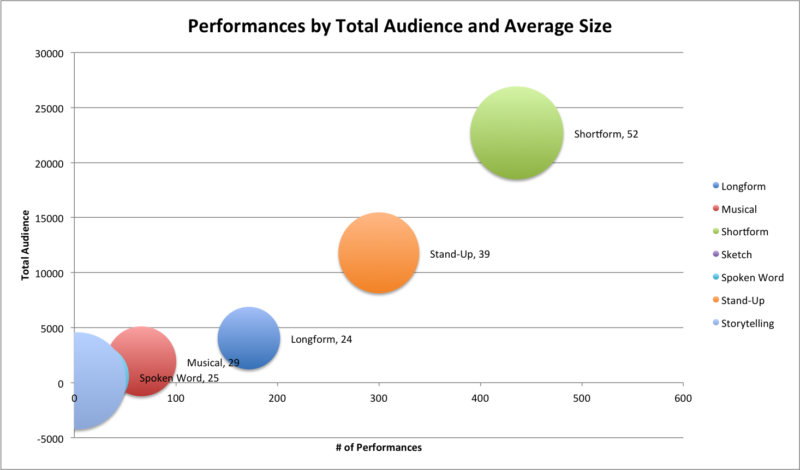
In total, 41,000+ people saw me perform live, an average of 41 people per performance.
My biggest show was for 1,200 people, a ComedySportz show for a Gildas Club event in Hackensack, NJ on November 3, 2011. We had Rachel Dratch as a guest performer that night, and needless to say (and yet I’m still saying it), it was an incredibly fun show.
My smallest show was for 4 people, which I did more than once, first with the 8th Floor, once with ComedySportz, and a few times in stand-up. These were some of the hardest shows I did, but if you can perform confidently in front of 4 people, you can also do it in front of 400.
11.8% percent of my shows were: for audiences of 10 or less; 10.3% were: for 100 or more.
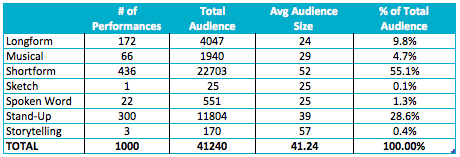
#1 Shortform (22,703 people)
55% of the people who saw me perform saw: me do shortform improv. That was 22,703 people, or roughly the entire population of Yukon City, OK, a 26-square mile city just outside Oklahoma City.
#2 Stand-Up (11,804)
28% of my total audience saw: me do stand-up at 11,804 people, or about the population of Baffin Island, a Canadian Island that resides mostly within the arctic circle.
#3 Longform (4,047)
10% of the 41,000 saw: longform at 4,047 people, or the approximate number of people living in Chunking Mansions,: a building located in Hong Kong.
Audience Size by Group
I also took: a look at audience size by group.

The top groups by total audience were: ComedySportz (15,000+), Smarty Pants (nearly 5,000), and stand-up (open mics at 4,800, MC at 3,500, and guest spots at 3,200).
The groups that were best at attracting an audience were being an MC (average of 150 people per show), followed by Smarty Pants (118), and Speechless Live (108). My indie improv groups didn’t do as well, with an average between 10-13 people per show.
Thoughts on Performances by: Audience Size
- People who have seen me live is a fraction of who have seen me online.: 41,000 people saw me in my first 1,000 performances. Compare that to the more than 1.8 million people who have seen my work on: YouTube, Twitter, Facebook,: reddit and: imgur. My Microsoft Office Pun has been viewed 1.4 million times (and has been stolen more times than I can count).
- I’m mostly seen as an improviser.: Though I’ve done 7 types of performances, 70% of the people who have seen me perform saw me do some form of improv. So to a majority of the people who have seen me, I’m an improviser (not a stand-up or storyteller).
- Stand-up audience size varies drastically depending on type.: The highest average audience size for any group was being the MC at a stand-up show with an average of 155 people. An average of 21 people were at stand-up open mics, one of the lowest averages per show. This makes sense as you’re not typically going to get a big audience for comedians working on new material.
Performances by Location
I was also interested in the number of places where I’ve performed. With my 1,000th performance, I had spoken or performed in all 50 states (and in 18 countries on 3 continents), but that included places I’d given a speech or led a workshop for Humor That Works, which I didn’t count: in these performance totals.
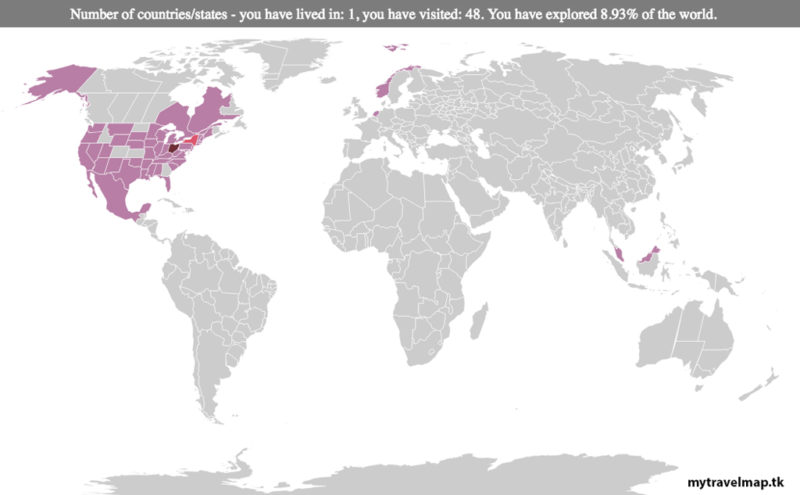
For just performances, I hit 45: states (missing Colorado, Georgia, Idaho, Kansas, and North Dakota) and two non-US: countries (Norway and Netherlands).

#1 New York (707 shows)
The top state was New York, where I performed: 70.7% of all of my shows. It was the only state where I did: every performance type, and was home to: 61% of my shortform shows, 70% of my stand-up, 94% of my longform, and 100% of my musical shows.
None of this was surprising given that I moved to New York for more performing opportunities and it’s home to some of the greatest (albeit smallest in physical size) stages in the world.
#2 Ohio (131 shows)
Next was Ohio, where I first started doing comedy, with 13.1% of my shows. A majority of those shows took place prior to moving to New York, but a number of shows came after the move, either for 8th Floor Alumni events or performing while in town for other reasons.
#3 New Jersey (20 shows)
The next closest state was New Jersey with a steep drop to just: 2% of shows.
Performance Types by State
I was interested to see how many locations I did each: performance type and I found: a large discrepancy between the types.

I did: stand-up in the most locations at 27: 25 states and 2 countries (both were English speaking shows).
Next was spoken word at 21. With only 22 total spoken word performances, every spoken word performance occurred: in a different state, with the exception of: Ohio, where I did two events.
On the opposite end of the spectrum, I only did longform in 3 states and storytelling in 2. I only performed musical and sketch in New York.
Performance Locations and Audience Size
After seeing the breakdown of: locations by number of shows, I took a look at the locations: by audience size.
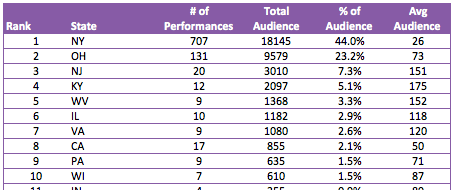
The top 3 states by audience were the same as the top states by number of performances, though the percentages were skewed (New York had 70% of the number of shows but only 44% of the audience).
Starting at #4 it got interesting, particularly in the average audience size. Kentucky, West Virginia, Illinois, and Virginia all averaged more than 100 people per show, with Kentucky: averaging 175.
New York, where a majority of my performances took place, averaged 26 people, the lowest average of any state where I performed more than twice, and 25th overall.
Performances by City
If I looked at the state level, it seemed natural to also look at the city level.
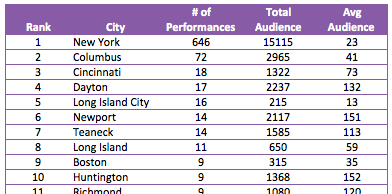
I’ve performed in 104 cities around the world (well mostly the US plus two countries). 63% of cities were for a single show; 8% of the cities were for 10 or more performances.
Manhattan (as in New York, NY) was the clear winner with 64.6% of all performances taking place in the big apple. Next up were Columbus (7.2%), Cincinnati (1.8%), and Dayton (1.7%).
That means 75.3% of my performances happened in roughly 381 square miles (22 for Manhattan, 80 for Cincinnati, 223 for Columbus, and 56 for Dayton). That’s 0.01% of the United States.
As a side note, I’ve also performed in a city beginning with every letter of the alphabet except for E, G, X, and Z. I know my next tour will have to take me to El Paso, Grand Rapids, Xalapa, and Zaozhuang.
Thoughts on Performances by: Location
- Great performances take place all around the country / world.: I’ve had the opportunity to be a part of shows in a lot of different places and I’m consistently impressed with the talent and diversity of performances. I’ve done open mics in tiny towns where performers have blown me away with their skill and passion. There’s certainly a greater number: of talented performers in the big cities like NY and LA, but there’s no monopoly.
- Some performance types are easier to travel with.: Stand-up is by far the easiest type of show to do as I travel. I can call up a club or find an event to: see about getting a guest spot, and they either say yes or no. Improv is a lot harder as most groups aren’t open to a stranger joining their group for a night: … Except with ComedySportz. I can contact a CSz city and see if they’ll let me join their show and they’ll often welcome me as a guest player (which I’ve done a number of times). It’s one of the many awesome things about the CSz family.
- The “big stage” has smaller audiences.: Something most people don’t realize about: moving to NY (or LA) to pursue comedy is that often you’ll end up doing more shows but for less people. This was true for me where I went from performing in comedy clubs (or on campus) in Ohio for 50-300 people, to performing in basements in NY for 10-20 people at a time.
Performances by Time
The final area I analyzed were my performances over time. Admittedly, I got a little carried away… I started first with performances by year (and ended up doing month, day, and time of day).
Performances by Year

My comedy career started with 3 performances in 2004 and grew steadily over time, reaching a peak of 154 shows in 2014 before dropping off. 42 days and 14 performances into 2016, I hit the 1,000 performances milestone.
#1. 2014 (154 shows)
The most performances I’ve done in a year was: 154. That’s an average of roughly 3 shows a week or 1 show every 2-3 days. I know there are plenty of performers who top that total, but that was quite a year for me.
#2. 2012 (134 shows)
2012 had the second most number of performances with 13.4% of all of my shows. Perhaps I was worried that the world was going to end so I tried to get all of my thoughts out before that happened.
#3 2011 (119 shows)
2011 was an incredibly busy year for me as I was still at P&G and was in the early stages of Humor That Works, yet: I still managed to perform an average of 2+ times a week for 119 shows.
Performance Types by Year
Taking a closer look at the performances yielded an interesting story of my evolution as a performer.
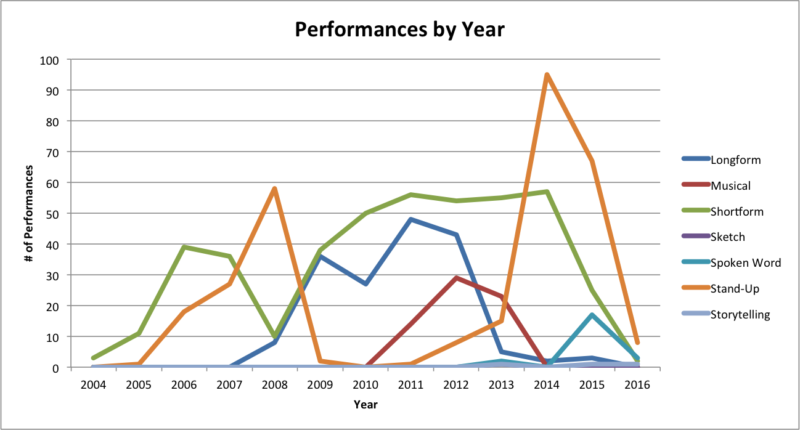
Over the course of 12 years and 1,000 performances, I had a number of shifts in frequency of performance types.

My 3 shows in 2004 were all shortform shows for the 8th Floor, all in Columbus, OH.
In 2005, I did 11 more shortform shows and tried out stand-up for the first time, averaging 1 show a month for a total of 12 for the year.
In 2006, the year I graduated college with a degree in the comedy-friendly Computer Science & Engineering, I made my first big leap, both in shortform shows (39) and in stand-up (18), jumping to a total of 57 shows that year.
The next 4 years were surprisingly consistent, starting with: 63 shows in 2007.: I say surprising because I moved from Cincinnati to NYC in 2008 and, despite being around a lot more comedy opportunities, my performances remained relatively steady.

With the move to NYC in 2008, I started doing longform and split most of my time between taking classes and doing stand-up (for a total of 76: shows).
In 2009, I started Humor That Works while still working at P&G and had to make a choice on what to focus on. I decided to continue taking improv classes and performed with ComedySportz while putting stand-up on the back burner, and ended the year with 76 shows (38 shortform, 36 longform, 2 stand-up).
In 2010, I focused exclusively on improv. I did 50 shortform shows and 27 longform shows for a total of 77 for the year.
By 2011, I had been introduced to musical improv and performed on 2 house teams (one musical and one longform at The Magnet) and consistently with ComedySportz. I did stand-up once. It was the first year I broke the 100 show barrier at 119.

In the middle of 2012, I left my job at P&G to focus on Humor That Works, which gave me more time to perform. I was in my groove on all of my improv teams and started to inch my way back into stand-up. I did 134 shows that year.
In 2013, I did my first (and only) sketch show, took a storytelling class, and tried spoken word for the first time. I also started traveling more for my business. As a result, I had to retire from my longform and musical teams because I consistently missed: practices and shows, which was unfair to the 6-7 other performers on the team.: To compensate, I did more stand-up again and just barely eclipsed the century mark at 102 shows.
My busiest year for any performance type was: in 2014 with 95 stand-up shows to go along with 57 shortform shows and 2 longform shows, for a total: of: 154 performances for the year.
2015 saw a decline across most performance types as I embarked on a nomadic journey. With: fewer performance options, I performed at poetry and music open mics which led to more spoken word and storytelling performances (and tremendous growth as a performer). Despite the travels, I still hit 113 shows.
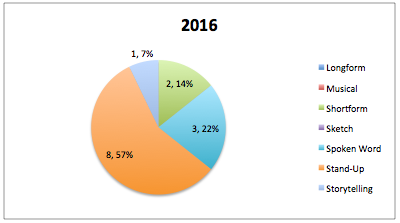
In 2016 I focused on hitting 1,000 performances and reached the milestone: with 8 stand-up shows, 2 shortform shows, 3 spoken word shows, and my 1,000th performance, a storytelling show in my 50th state (Hawaii).
Audience Size by Year
From some of the other analyses I realized that number of performances didn’t necessarily correlate with higher total audience, so I took a look at total audience size by year.
My best year for total audience size was actually in 2007, when I “only” did 63 shows. Many of those shows were for high schools as part of Smarty Pants, some of which were: in front of upwards of 900 kids.: That was also the year I did my first paid stand-up spots as MC for a couple of different Funny Bones, each show averaging between: 150-300 people.
2014, the year with the most performances, was third in audience size because many of those shows were smaller stand-up venues in NY.
Performances by Month
After I looked at the performances by year, I was interested in the breakdown of performances by month (both on average and each year).
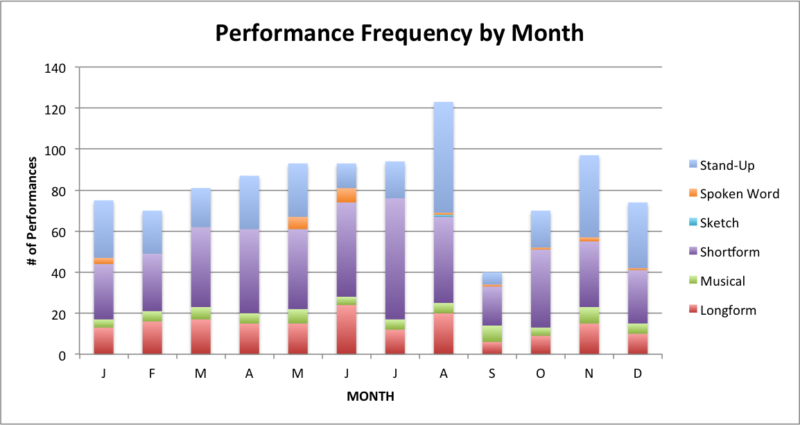
The busiest month of the year for performances was August, with 12.3% of my total performances.
My slowest month immediately followed: (September) with only 4.0%. Perhaps I got tired from all of the shows in August and took some time off.
Every other month was in the 7-10% range (70 to 100 shows).

The reason August was the highest month: was largely driven by stand-up, with 54 shows, beating the average number of stand-up shows per month (25.2) by almost 29 shows.
The most popular month for shortform was July (often when ComedySportz World Championship takes place) at 59 shows (vs an average of 36.3).
June was the month for longform (24 shows vs 15.9 average, when DCM is) and spoken word (7 shows vs 1.7 average, the month of my two-week road trip in 2015).
Musical was pretty evenly distributed, and sketch and storytelling were too small of a sample size to focus on.

The most shows I ever did: in one month was 40, back in August 2014 (also the most stand-up shows I’ve done at 38). The next highest month was 20, which I did twice, in November 2014 and May 2015.
The most improv shows I did in one month was 19 in July 2012, where I did the most shortform shows I’ve ever done (13) along with some longform and musical.
I performed in 8 longform shows in a month twice (June 2011 and March 2012), and the most musical shows I: did: in one month was 5 (November 2011).
I also performed at least once every single month from December 2007 to February 2016.
Performances by Day of the Week
After I saw: the monthly breakdown I was: curious about the daily breakdown.
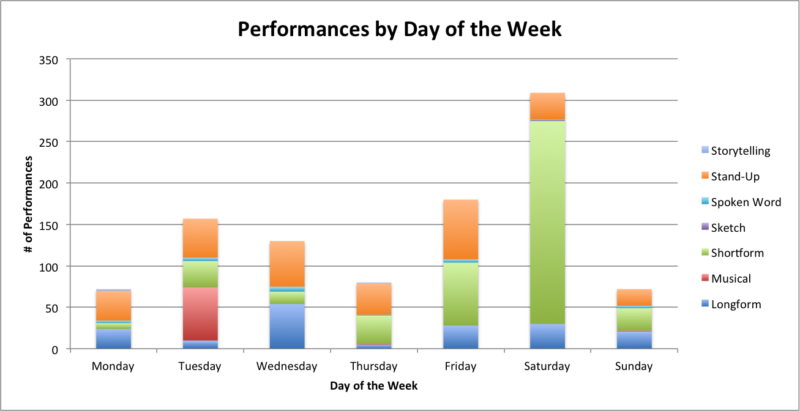
It was no surprise that Friday and Saturday were the two most popular days of week for me to perform: as that’s when most comedy shows happen.
After which it appeared I liked to take a few days off, as Sunday and Monday were my two least popular day for shows.

#1. Saturday (309 shows)
Saturday was the top day for shows with 30.9% of all performances coming on that day. The popularity of Saturday was driven primarily by shortform shows at 245 performances. I suppose that’s what happens when you: perform a weekly Saturday show with ComedySportz NYC for 8 straight years.
#2. Friday (180 shows)
Friday was the second most popular day for shows at 18.0%. It was also the most popular day for stand-up specifically (72 shows) followed by Wednesday (55), Tuesday (47), Monday (36), and then Saturday (32). It appeared hard: to do stand-up on Saturday when I: did so much improv that day.
#3. Tuesday (157 shows)
Tuesday was: #3 with 15.7% of shows. This was: a bit surprising, I would have guessed Thursday or Sunday would be more popular. However, 97% of my musical improv shows came on Tuesdays (that was musical improv day at The Magnet), which bolstered the numbers.
Monday and Sunday were my least popular performance days at 72 apiece.

The majority of people saw me perform on Saturday (28%) and Friday (23%), though average audience sizes were bigger on Sunday (55 people per show) and Friday (52). It appeared to be the hardest to get people to come out on a Monday (only 23 people per show and 4% of my audience).
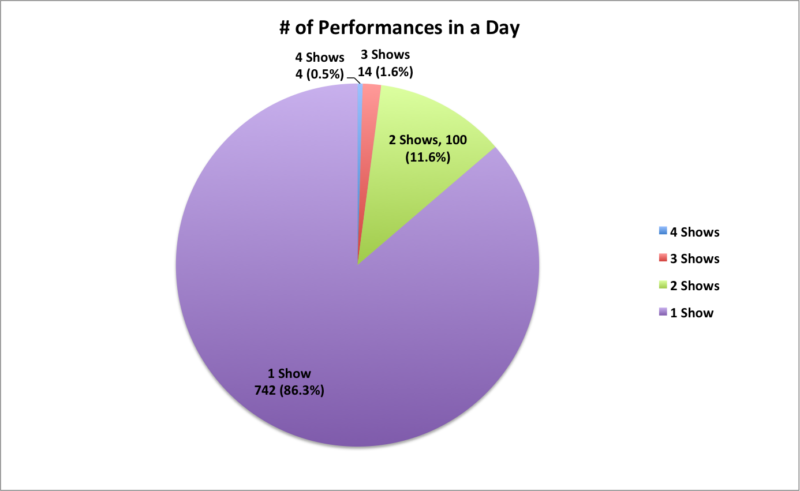
The most shows I did in a single day was: 4, which I did 4 times. Interestingly all 4 times were either all shortform shows or all stand-up shows. When I wanted to perform a lot in a day, apparently I didn’t: switch up: type of performance.
I did 3 shows in a day 14 times (with diversity in performance type) and 2 shows in a day 100 times. 86.3% of the time: it was just a single show that day (742 shows / 742 days).
Performances by Time of Day
I had already reviewed yearly, monthly, and daily: data, so I figured I might as well jump into the time of day for each of my performances as well.
I didn’t keep track of when exactly I performed so I had to go back and add time-of-day to my excel sheet (Note: this is start time of the event, not necessarily the exact time I was on stage).
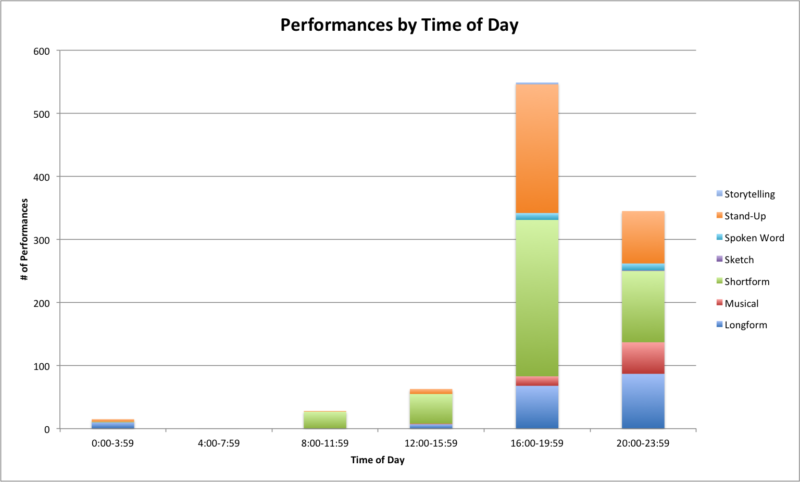
Once I did that (and figured out how to put the data into buckets), the obvious trend emerged: I performed more often at night.
#1. 4pm to 8pm (549 shows)
54.9% of my shows started: between the hours of: 4pm-8pm, the earlier side of primetime.
#2. 8pm to 12am (345 shows)
34.5% of my performances started between 8pm-12am, the later side of primetime. Of the two primetime slots, I clearly favored earlier rather than later.
#3. 12pm to 4pm (63 shows)
A distant third to primetime was the early afternoon timeslot, when a lot of remote shows happened.
Similarly, the hours of 8am-4pm were dominated by shortform, a popular timeslot for private shows through Smarty Pants and ComedySportz.: I did do stand-up once at 10am at a corporate event and it went about as well as you’d expect a 10am stand-up show to go.
I never: performed between the hours of 4am-8am (perhaps a late-night bit: show at DCM or a poorly planned stand-up show is in my future).
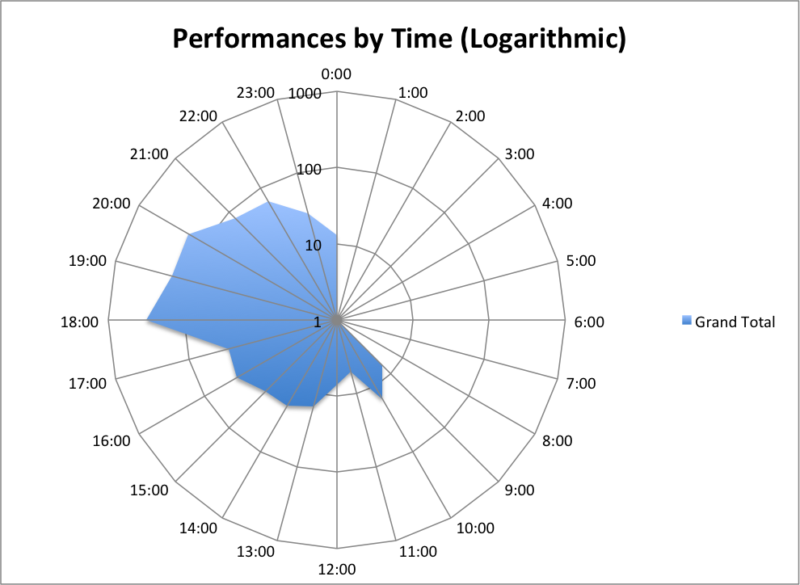
Getting a little more specific (and using a log scale to see more data) showed the typical performance times, with a peak from 6pm-8pm (when 66.5% of my performances started).
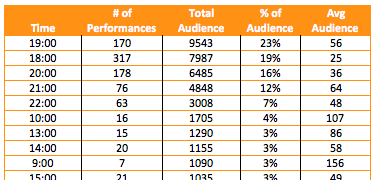
The most number of people saw me at 7pm (9,500 people), then 6pm (nearly 8,000), then 8pm (6,500). In fact, 77% of people saw me perform between the hours of 6pm and 11pm.
Average audience per show was highest at 9am at 156 people per show, followed by 10am with 107 people per show. Which makes sense in a way; the only time you’re going to convince someone to do comedy at 9am is when it’s: a paid, private event for a large group of people.
For the evening hours, 9pm saw the biggest audiences at 64, then 7pm (56). Weirdly I did smaller shows at 8pm (36 people) than I did at 10pm (48).
Thoughts on Performances by Time
- My performance types varied by year.: There’s a natural ebb and flow to the different types of performances I did. Performance opportunities were driven by what was going on in my personal life, where I had been taking classes, and what I had been focusing on. I’m currently doing more stand-up, so the next 1,000 performances might look very different.
- Performance burnout is real.: I love performing but it does require energy, which means it also requires resting.: My busiest month of shows (August) was followed by my slowest (September). My two busiest show days (Friday and Saturday) were followed by my two slowest (Sunday and Monday).
- A lot of my work happens at night.: I am not a morning person which is probably a good thing if part of my job is performance. A majority of shows happen at night and it’s tough to do a show at 10pm if you’ve been up since 6am (that’s also why Friday late shows are notoriously more difficult to do, because the audience gets tired from being up all day).
Summary of Analysis
The analysis of 1,000 performances started just because I could. I had already tracked the data (I used it as a way to motivate myself to perform) and decided I might as well look into it.
Through the process, I learned some things about myself, including:
- I’ll always want more data.: As I began my analysis, I found myself wishing I had more data. In some cases, I went back and created it. I didn’t initially track the start time of my shows, but when I realized I wanted it, I went back through 12 years of calendar data to add it to the file. I really wish I had ranked my performances on a scale of 1 to 5; I’d love to see if there were any trends between: performance rating and things like type, audience size, or time.
- I am far more experienced as an improviser. I knew I had done more improv than stand-up, but didn’t realize how big the gap was, particularly between the number of hours performed in each.
- I’ve thoroughly enjoyed (and benefited from greatly) being apart of ComedySportz.: I knew emotionally that I’ve enjoyed being part of the CSz family, but the data showed logically why it’s been great for me. It’s given me a chance to perform frequently, in all types of spaces, at different times, and in different cities.
- I want to expand more online.: Performing live is incredible, there’s nothing quite like hearing the sound: of a group of strangers laughing at something you’ve said or done. However, I can reach far more people online than I could ever hope to reach in person. Luckily these two things are complementary. I can perform live, record the set, and post it for others to see. Or I can take bits I’ve worked on live and translate them to text or images to share with others.
- Laughter is universal, what makes people laugh is not.: Everywhere I’ve gone, I’ve been able to find a community that is eager and willing to laugh. What they’ll laugh at, however, changes based on where I am. Norwegians loved my material on the metric system, Alabamans did not. Spoken word audiences tended to appreciate wordplay, late night stand-up crowds not-so-much. Part of the fun of performance is solving the puzzle of: each unique audience.
I’m excited to see how the next 1,000 shows compare.

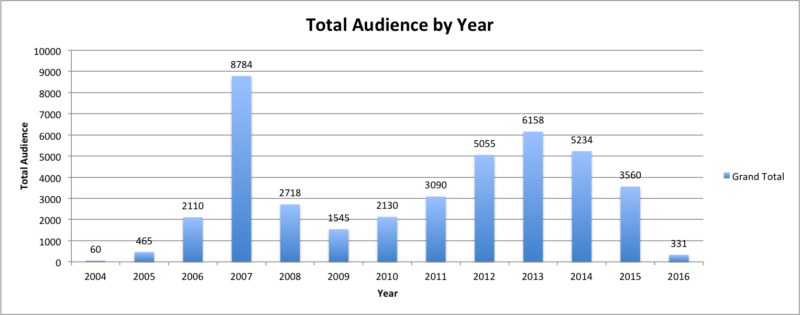
drew, you are amazing. this thing is insane and my non-linear brain exploded after the first page, but i commend you for an incredible document! congrats, birthday-buddy!
Wow! You are an engineer. I’ve never seen an analysis so precise!!! Good for you.
I’ve only seen you once live (at the Funny Bone), and I’ve viewed a couple of your improvs and a couple performances you’ve shared with corporations.
I think your trade is outstanding. I’d say that you’re a pioneer in your field. Good for you, Drew. Your grandfather, Charlie Lea, would’ve been impressed with your chosen field. I remember seeing Charlie always with a smile.
Your Mom is a very special friend. I recently lost my husband of 21 years. Your Mom has been “right there” for me. LuAnn is special human being. You’re truly blessed to have the parents you grew up with.
Thanks for sharing your stats, Drew. Keep on with your trade. Humor is one of the most important things in the world. The fact that you provide an outlet for all to laugh, to de-stress, to relax is very important. Congrats to you and your ongoing success. I look forward to seeing you in Cincinnati again.
Pingback: Can You Learn to Be Funny? Yes – Humor at Work